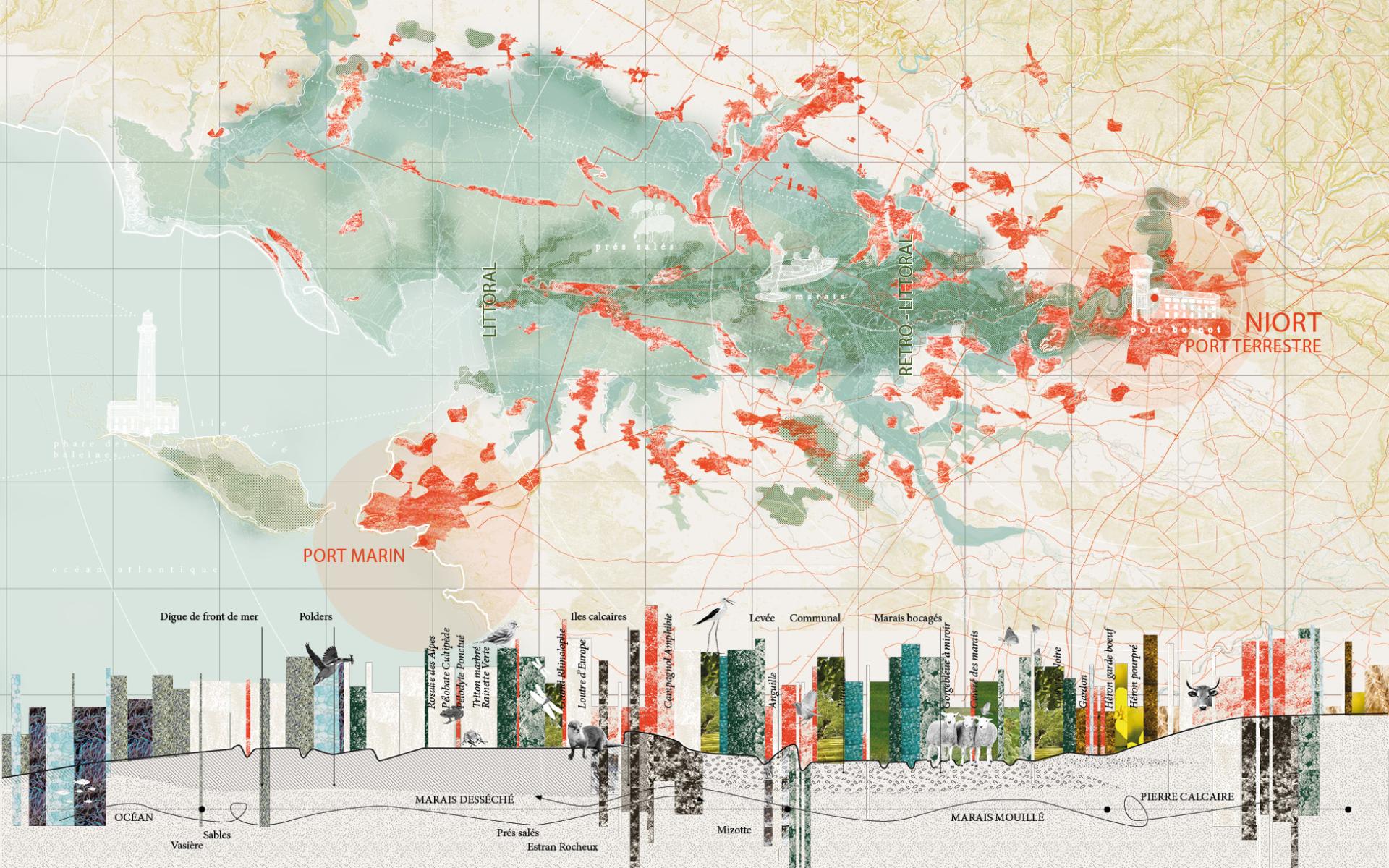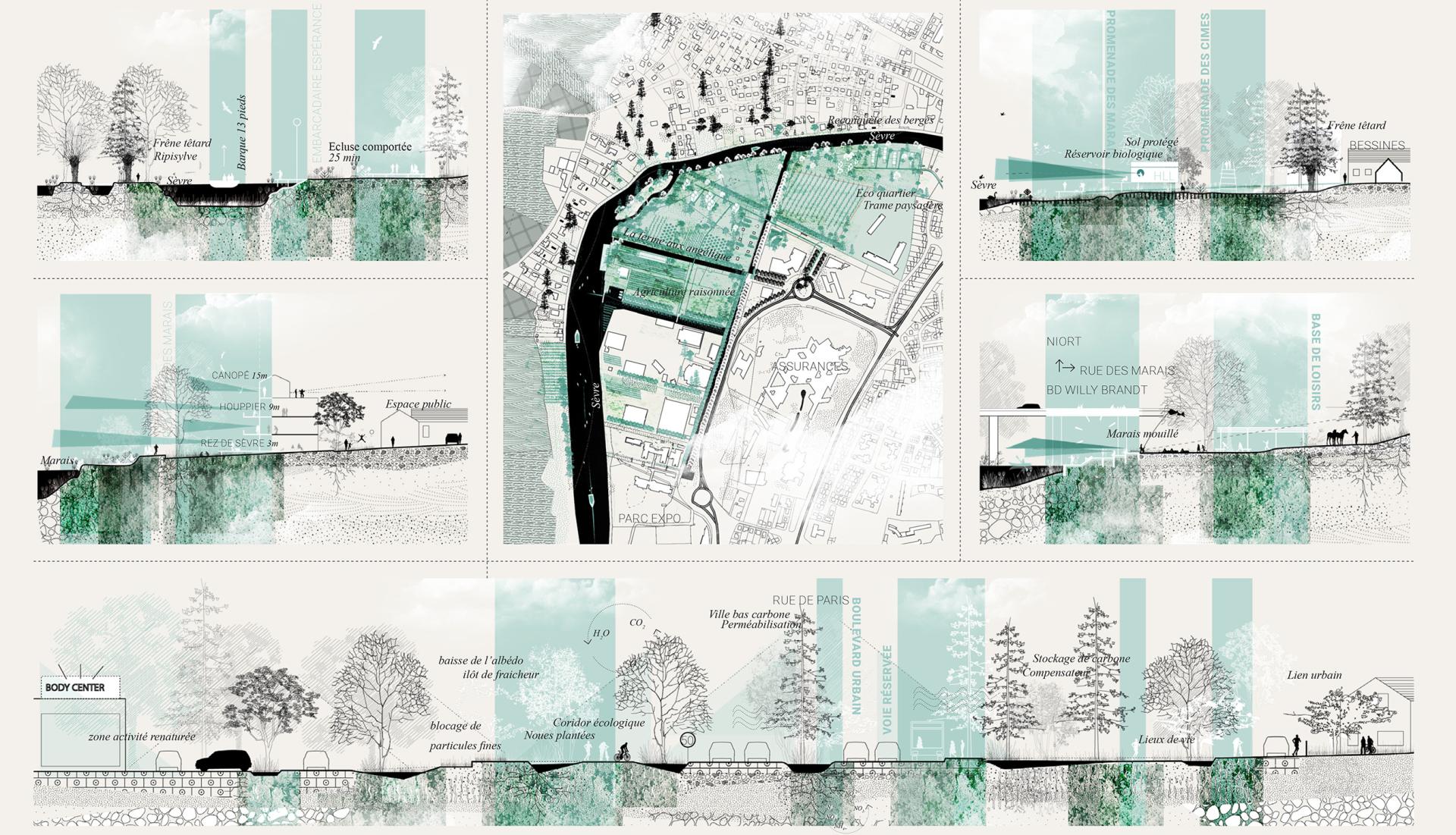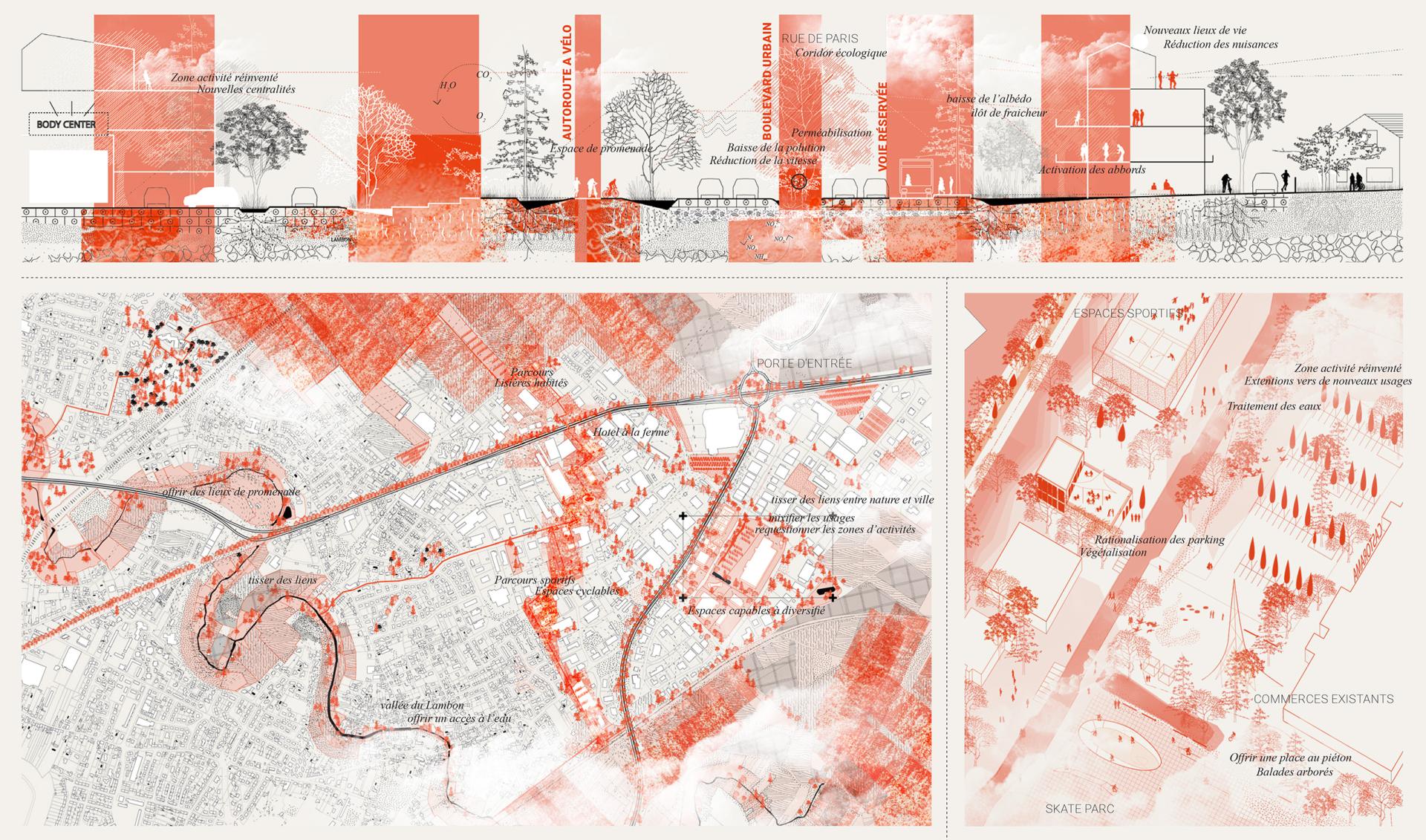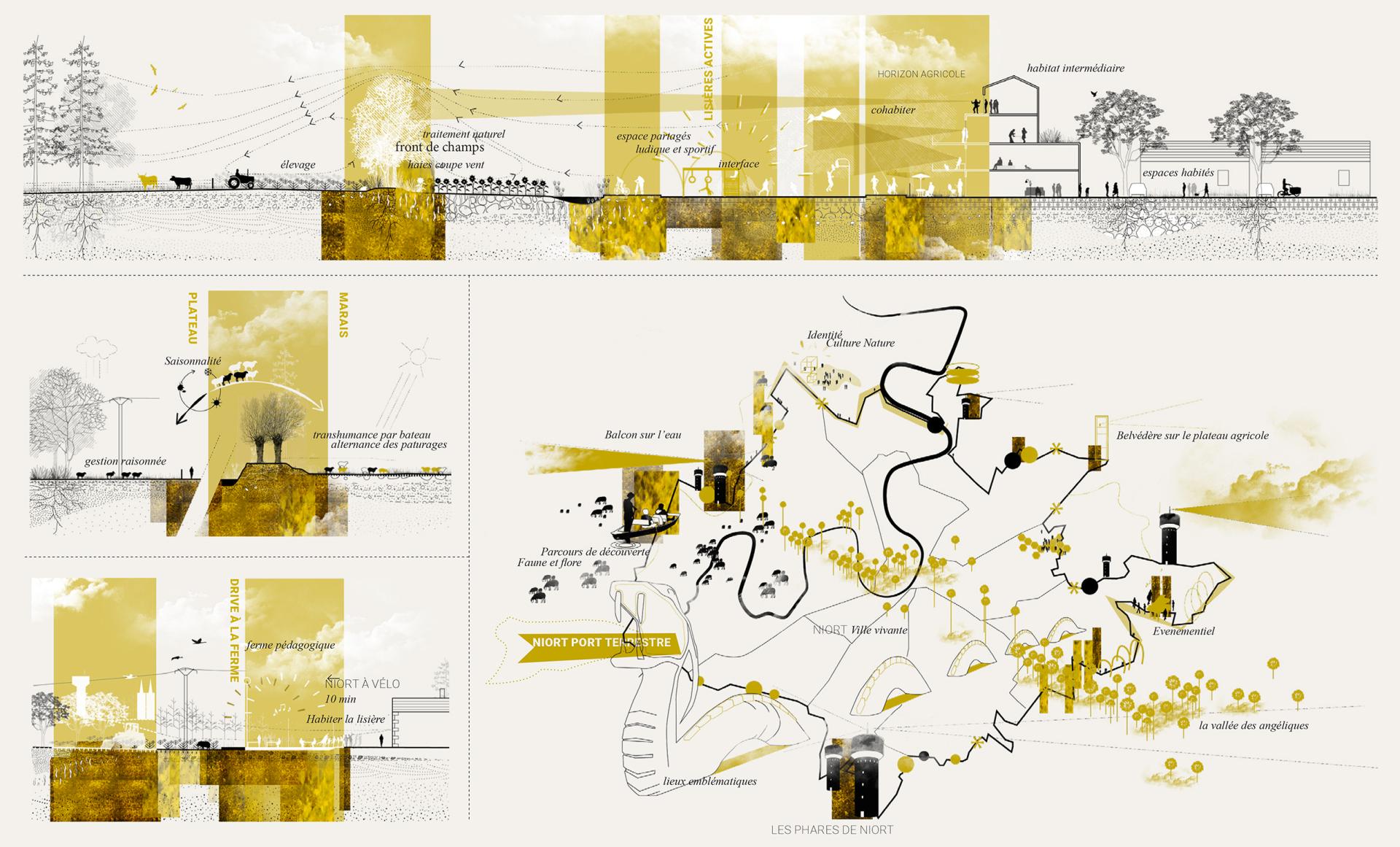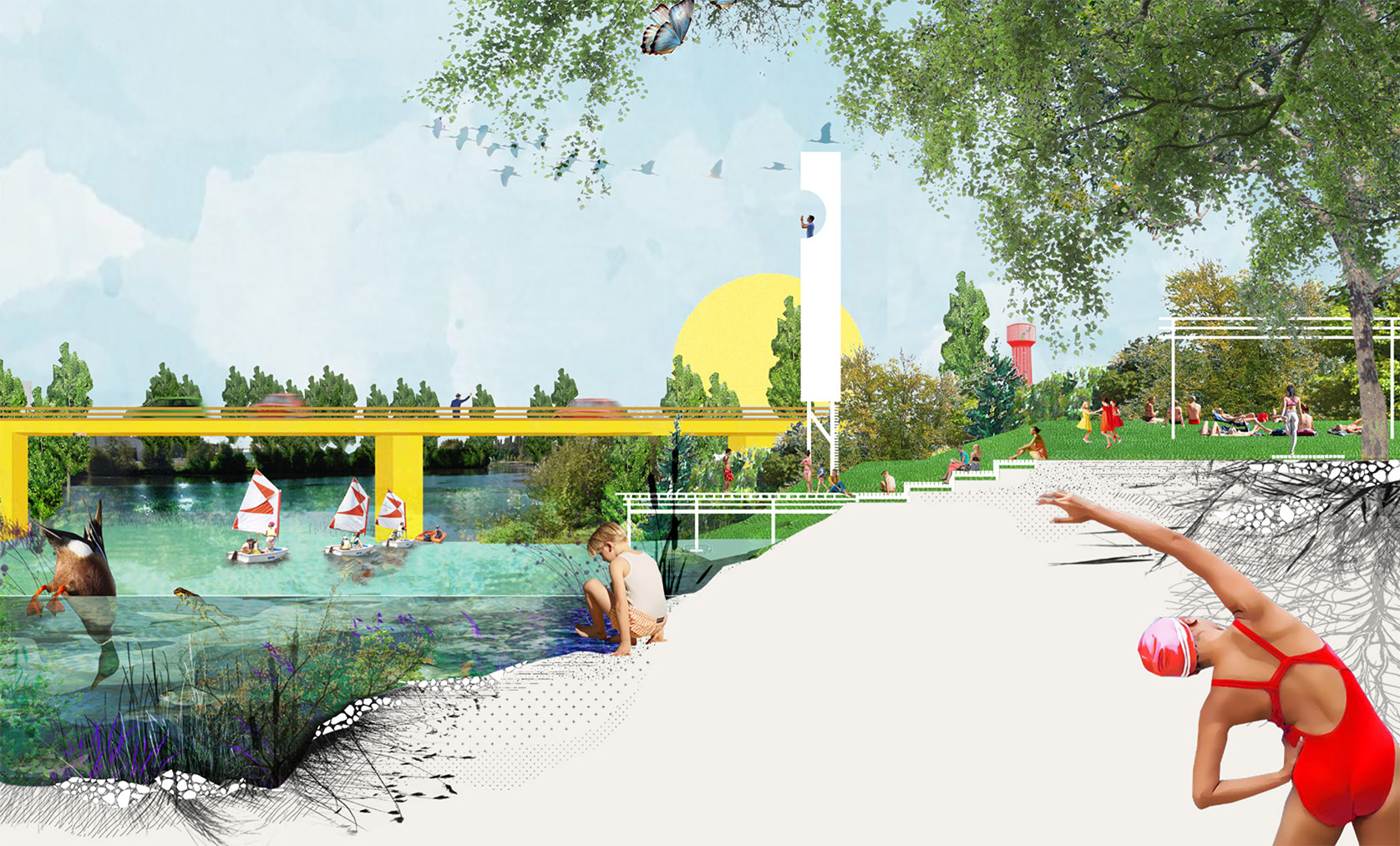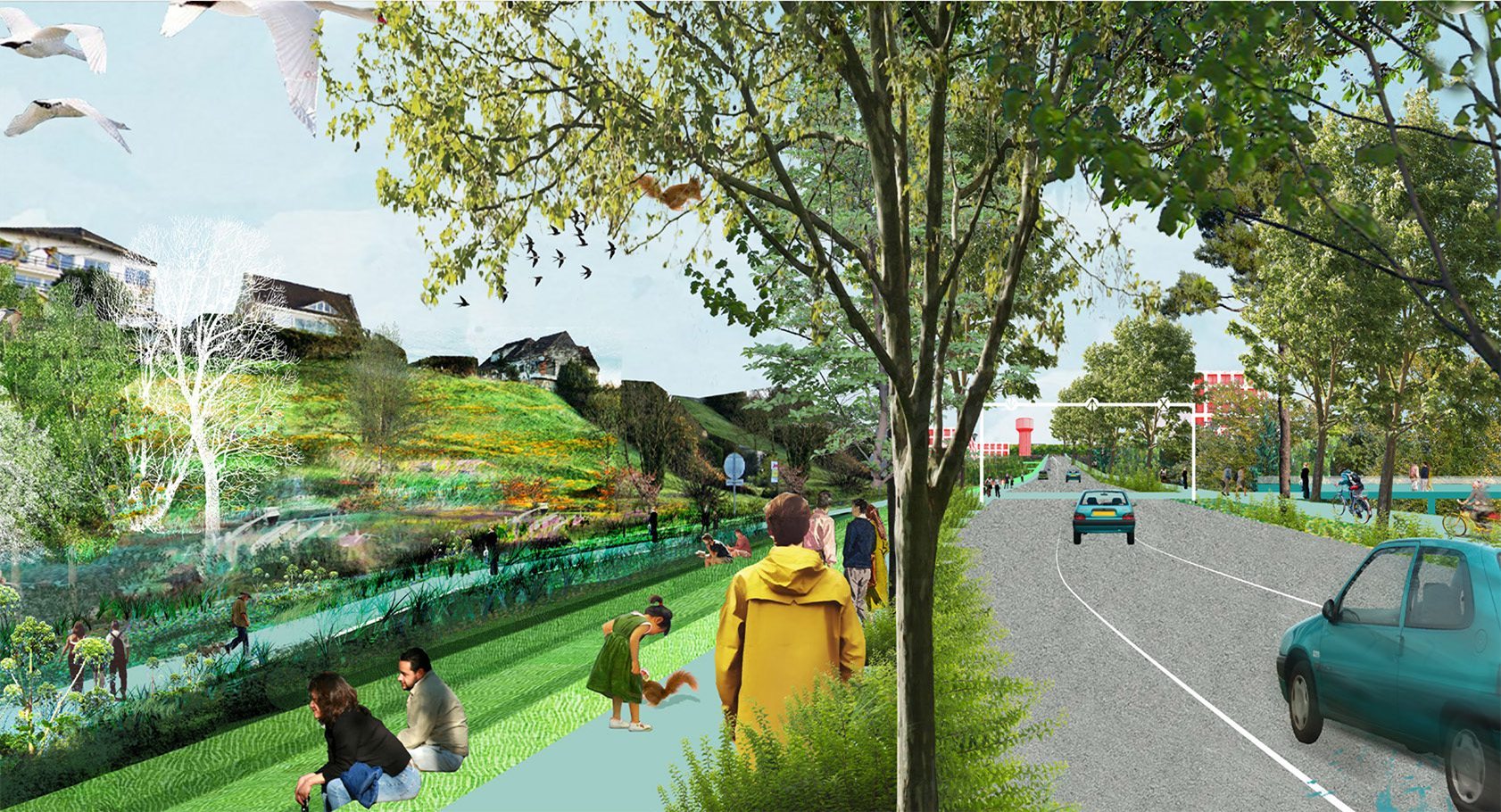Niort, Land Port
Basic information
Project Title
Full project title
Category
Project Description
Bordering a fluctuating marshland,Niort is a land port overlooking the wetlands and leaning back against its agricultural hinterland.At the heart of an intricate landscape systems,we're developing a transverse approach of habitability and natural habitats. We are aiming towards a new policy framework (PLNUI) in which nature is raised at the same level as the need for urban development.Niort is emphasizing its position as a living city where nature and infrastructure create a new ecosystem.
Geographical Scope
Project Region
Urban or rural issues
Physical or other transformations
EU Programme or fund
Which funds
Description of the project
Summary
The « Intergovernmental Panel on Climate Change » report from 9th of August 2021 is irrevocable. The human action on economic, urban and productive development has transformed the exchange approach and the environmental control. In such a way that we will be facing frightening and uncontrollable events: rising floodwaters, droughts, heavier rainfalls and less distributed… these results will redistribute the overall, the human living, a wide ranging and invisible concept, however un the center of our current concerns. We are interested particularly in the city of Niort and its relation to the coast and its geography: do we have to battle against the elements by reinforcing the dykes, by increasing protection against the inevitable rising floodwaters? Or should we support the rising floodwaters in its variation? we are sure that the second option is the right one.This thinking is the starting point of our reflection on geography and land. Our approach first focused on the land, the observation and the decoding, the understanding and the survey of the potential assets: a vegetal and cultural heritage, rich and diverse views, invisible property, over calibrated installations, numerous activities, rich grounds, the presence of water, a variety and abundance of landscapes… starting point of a various shades of land.
Key objectives for sustainability
The territory of Niort is particularly vulnerable to climate change, because of its proximity to the ocean, the many rivers and marshes that cross it, and its topography very close to sea level. tourism and with a strong agricultural dimension, the pressure on already fragile ecosystems is twofold: human and climatic.
Our proposal consists in inventing a method and a framework document for sustainable planning (the PL(n )Ui), in which we project ourselves into 2100, that is to say well beyond the time of a political mandate. It is a question of starting today the adaptation of the city and the existing countryside to the climate of tomorrow, by relying first on the revelation and the protection of the great natural infrastructures, then by declining an operational strategy of urban renewal respectful of these and adapted to the new physical constraints of climate change. It is no longer a question of fighting against but of welcoming the new physical constraints of climate change in order to generate new forms of productive landscapes and natural architectures. It is no longer a question either of extending the city but of sanctuarizing its limits and adapting what already exists to make it more sustainable. It is not only a question of supervising the development in each sector but also and above all of thinking about the relations between these different sectors.
We are particularly interested in contact zones to invent a lexicon of living edges: fertile and three-dimensional interfaces between natural and anthropized environments where there is a mutual valuation (circularity) of space, resources and living conditions. lives, for man but also for fauna and flora, always with water as a support for life, uses and the diversification of ecosystems. Our proposal is thought out in cross section in order to highlight the new positive alliances to be implemented between the different natural, agricultural and inhabited environments.
Key objectives for aesthetics and quality
Our proposal seeks to magnify the diversity and complexity of the landscapes and ecosystems present, by amplifying the presence of water in and around the city. We make consequences of global warming (flooding), a project support and a new urban aesthetic assumed. The water of the marsh, the water of the rivers and the water of the rain and the water of phreatics are a complex and extremely ramified system that would enrich the quality of public spaces. Water will be omnipresent in the public space helping to diversify the landscapes and plantings, to provide habitats for wildlife, to fight against the heat island and to offer fun spaces.
This objective implies, for example, finding a maximum of living soils and landscaped areas in the heart of the city, thus reconnecting the inhabitants with the rhythm of the seasons, and working on all strata from the basement to the tops of the trees to create vertical ecosystems to fuel the water and carbon cycle.
At the edge of the agglomeration, between fields and housing estates, wooded edges would redefine a fertile boundary creating climatic, social and constructive synergies. Rainwater from housing estates would be collected in wooded cordons which, in exchange, through the combined presence of trees and water, would help to naturally air-condition these extremely mineral and waterproofed ends of towns. Plots of urban agriculture could be included, thus generating new collective uses in neighborhoods with a very individualized way of life. Finally, the wooded cordons would be sculpted to both create stunning frames on the horizon and protect the dwellings from the prevailing winds.
The landscape is both a support for a new urban aesthetic and for climate regulation.
Key objectives for inclusion
Our proposal for the conurbation of Niort opens up a reflection on a very vast territory, both urban and rural. Aware of the complexity of the issues and the large number of private and public actors concerned by a new philosophy of sustainable development, we have designed a flexible project tool (the "lexicon") and five major territorial strategies (the PL(n )Ui) rather than a frozen drawing on a specific site. Our proposal consists of both the development of an evolving masterplan at the intermunicipal scale and the development of a method of co-designing this masterplan based on thematic workshops with the many elected officials, private stakeholders and the civic sphere. Firstly, agreeing on a project method and common objectives is a solid prerequisite which then makes it possible, in partnership with all the players, to achieve a concerted and locally adapted space project.
We did not hesitate to rely on the IPCC projections to create a collective electric shock and to begin a common reflection on the making of a resilient city for tomorrow: we are thus seeking to introduce the notion of risk, mutability, natural hazards and living environments in urban planning framework documents. We seek to reverse the order of priorities by establishing nature as a common good that it is essential to preserve in the dynamics of urbanization. This means reconsidering the notions of private property and the porosity of the territory in order to guarantee great ecological continuities. If we seek to introduce a real change in development habits that will have an impact on land management and on the development of both public and private spaces, it is unthinkable that this be done according to a top-bottom approach. Thus the participatory method that we want to put in place is an iterative process between expert work and work with the population. This process would be unprecedented in its scope, its longevity and the values of collective intelligence that it promotes
Physical or other transformations
Innovative character
We propose a new working method to the elected officials of the City of Niort for the collective writing of a story of adaptation of the city and the existing countryside to climate change. This new vision, drawn up over several years and involving a group of multidisciplinary experts, elected officials, citizens and major private players naturally promotes the values of sustainable development, a new aesthetic of development and inclusiveness :
- put the integrity and efficiency of the major natural and hydraulic continuities in the foreground to rethink land use and the notions of public and private property
- place the ecosystems, the presence of water and plants at the heart of a new aesthetic for the development of public space and architectural (bioclimatic architecture) and constructive (organic and geo-sourced materials) typologies
- Include a large number of actors in the reflection and writing of one or more scenarios for the transformation and adaptation of the territory, so as to empower and be creative from the ultra-local scale (inhabitants' initiative) to at the intermunicipal level (political strategy).
In doing so, we imagine that the city of Niort could become a pilot and exemplary city in France in terms of resilience, sobriety and autonomy, giving real impetus in the face of the climate emergency.

